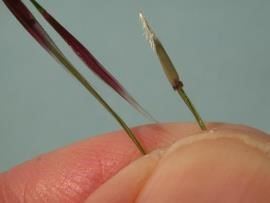This is a summary of the key points from the webinar and paddock walk on plant identification with Jo Powells, Geoff Robertson and Margaret Ning in March 2022.
You can watch the webinar by clicking on this link.
The key messages from this paddock walk are summarised below, and links to further information on each topic can be found at the bottom the page;
- Grasses are usually categorised by the shape of their seed head.
- Different parts of grasses are used to identify species these include nodes, auricles, leaf shape and ligules. The presence and absence of hairs on the leaf, nodes, stem and other parts of the grass can also help identify different species.
- Perennial grasses are classified as C3 or C4 grasses, this refers to the way in which the grasses capture carbon dioxide during photosynthesis. They are adapted to different environments, with C3 grasses found in temperate areas, while C4 grasses come from tropical climates.
- Cocksfoot grass has branched, open panicles and is folded like a book at the base of the leaf, phalaris has a round stem with cylindrical seed head.
- Grass weeds such as Serrated Tussock, Chilean Needle Grass and African Love Grass can be a big problem for property owners. African love grass has a seed panicle that looks like a Christmas tree, Chilean Needle Grass has distinct ribbed, hairy leaves and a corona at the base of the seed awn. Serrated tussock is largely indigestible and can cause animals to die of malnutrition. Find out more about these weeds in the NSW DPI Weed Wise App.
- Not sure what you’ve got at your place? Contact South East Local Land Services, local council weeds officer or try logging your sighting on the Canberra Nature Map website or app for identification.
 Chilean Needle Grass Seed Head – Photo NSW DPI
Chilean Needle Grass Seed Head – Photo NSW DPI
Jo Powells is a Senior Agricultural Adviser - Pastures from South East Local Land Services based in Cooma.
Contact your nearest South East Local Land Services Office.
Resources
Friends of Grasslands (FOG) – Parts of Grasses
Department of Primary industry and Fisheries – C3 and C4 Grasses
Ag Guide Pastures in Farming Systems
Grasses of the NSW Tablelands
Canberra Nature Map
NSW DPI pasture plant species and varieties
Grass Identification
This event was made possible with funding from the Australian Government thorough the National Landcare Program and in-kind support from South East Local Land Services.